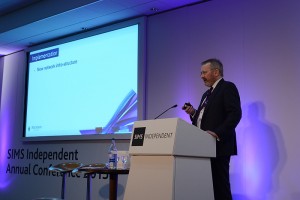Get your message across clearly to every delegate in the room
Full HD projection explained, and why it’s our standard for large screen events
When a client asks for a large projection screen, we know that what they are really asking for is a screen large enough for their content to be seen clearly. However, the clarity of what you see on the screen is based on much more than size…
We all know about HD televisions; you may even know that the terminology for ‘Full HD’ is ‘1080p’, but what does that mean, how can we relate that to projection screens, and why is it important?
HD (High Definition) relates to how many coloured dots (called pixels) that make up an image: the more pixels the clearer the picture. Until recently, projectors have projected in standard definition. Code Audio Visual has recently invested in new, high-quality HD Event projectors and associated equipment, and made HD our standard for projection. The main reason for that is because the clarity of the projected content is considerably higher, meaning that your images and content are much sharper. For those attending your event, people close to the screen will not see pixelated unclear content, and those further away will be able to read the content with ease. As projection on a large screen is all about conveying a message to a large number of people, it’s imperative that that message can be seen as clearly as possible by your attendees.
High definition in products you use every day
 Screen resolution is something that companies like Apple have put at the forefront of their product design. For example, the iPad Air’s screen resolution is 2048 pixels across the top of the screen and 1536 down the side. With a screen size of just less than 10 inches, this means that over 3 million pixels make up the tiny iPad screen and make it crystal clear, known as Apples Retina Display.
Screen resolution is something that companies like Apple have put at the forefront of their product design. For example, the iPad Air’s screen resolution is 2048 pixels across the top of the screen and 1536 down the side. With a screen size of just less than 10 inches, this means that over 3 million pixels make up the tiny iPad screen and make it crystal clear, known as Apples Retina Display.
Most laptop screens use a resolution of 1366×768 which is about 1 million pixels. On a screen size of 15 inches, that’s a lot of tiny dots in a small space so the image is very clear.
Most televisions these days are what is termed ‘Full HD’, the definition of Full HD is 1920 pixels across the top of the screen and 1080 pixels down the side, again a widescreen format. Most televisions are between 40 and 50 inches and in that space we find about 2 million pixels making up the picture. At this size it is possible to look closely at the screen and see the tiny dots. The picture is clear from a distance as TV is generally viewed, but close up its nowhere near as detailed as the iPad which wins hands down.
Large screen projection
So, onto projector screens… For everyday events use generally a 10’ screen is used as it fits with the size of the room. This can either be 10’ x 7’6” in 4:3 format or 10’ x 5’5” in widescreen format
To compare:
- The tiny iPad Air, with its fantastically detailed screen, has 3 million pixels in 10 inches – amazing quality screen.
- Laptops generally have a 15” screen, in that small size they fit 1 million pixels to create a fairly good quality screen which is clear to read.
- Televisions which are ‘Full HD’ and 40 to 50 inches in size, have 2 million pixels spread across their large screen, the picture is pretty good.
Standard projection
The standard for projection in the audio visual industry is 1024 x 768. On a 10′ screen (not 10″ like the iPad Air), this is only 780,000 pixels. The resulting image is reasonable at some distances, but for those nearer the back, small text will be difficult to read, graphs with fine lines will be unclear, and images won’t look crisp. Those nearer to the screen will see text pixelated or unclear, small text is unreadable.
 Full HD projection compared with standard
Full HD projection compared with standard
Full HD widescreen projection is the same resolution as an HD television: 1920 x 1080 – 2 million pixels, which is a staggering 256% increase based on standard projection. The difference between the two is undeniable, which is why Code Audio Visual has made HD their standard for projection.
How to ensure you get a clear picture at your large screen event
To provide the best experience and clearest images for your event attendees, you should specify a full HD projector (available in 1920 x 1080 for widescreen format screens, or 1600 x 1200 for 4:3 screens).
You must also ensure that the presentation is made in the correct resolution to match, that the computer it is running on is capable of that output (most laptops are not), and the presentation switcher that the AV company use is also capable of the same Full HD resolution.
The FULL HD works by Code Audio Visual
As stated previously, we have invested heavily in a range of equipment including projectors, switchers, specialist laptops etc. to enable us to provide Full HD projection for our clients. In addition to providing the right equipment, we will also convert your presentation at no charge, so that it looks it’s best on screen.
Code Audio Visual have now made FULL HD our standard for large screen projection events such as conferences, roadshows and awards evenings, because quite simply, it makes no sense to continue using standard.
To discuss your next event, contact Code Audio Visual on 0800 644 6165.
The writer Gary Wrench is director of Code Audio Visual in the UK. Code Audio Visual provide an expert, quality service and project in Full HD as standard: www.codeav.com

